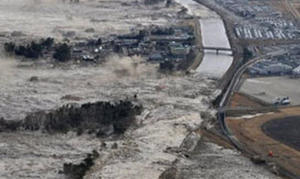DisastersJapanese government anticipated tsunami's effects at nuclear plants
Growing evidence suggests that the Japanese government and Tokyo Electric Power (TEPCO) ignored clear warnings that infrastructure at the Fukushima Daiichi power plant would be damaged in the event of a massive earthquake; Japan’s Mainichi Daily recently obtained government documents that indicate a government research group clearly outlined the effects of tsunamis on nuclear plants; as TEPCO battles to contain the radiation spewing from the Fukushima Daiichi reactors, the power company and the government have insisted that the 11 March earthquake and tsunami that knocked out cooling systems at the Fukushima Daiichi plant was well beyond their expectations

Tsunami rushes inland // Source: citypictures.org
Growing evidence suggests that the Japanese government and Tokyo Electric Power (TEPCO) ignored clear warnings that infrastructure at the Fukushima Daiichi power plant would be damaged in the event of a massive earthquake.
Japan’s Mainichi Daily recently obtained government documents that indicate a government research group clearly outlined the effects of tsunamis on nuclear plants. The study, completed by Japan’s Nuclear Energy Safety Organization, said, “Our analysis shows that a tsunami of a certain height (some 7 meters in the absence of a seawall and some 15 meters if one were present) or higher would have almost a 100 percent chance of damaging the reactor core…”
The report went on to say, “We presume a tsunami of at least 7 meters would destroy the functions of a seawater pump and that of at least 15 meters would destroy outside equipment such as an electrical transformer.”
As TEPCO battles to contain the radiation spewing from the Fukushima Daiichi reactors, the power company and the government have insisted that the 11 March earthquake and tsunami that knocked out cooling systems at the Fukushima Daiichi plant was well beyond their expectations.
Yet the damage that the massive 9.0 earthquake and the ensuing 46.5 foot (15 meters) tsunami wave caused the power plant was foreseen by the Nuclear Energy Safety Organization’s report.
The Fukushima nuclear plant was only designed to withstand a roughly twenty foot tsunami.
In a speech on Wednesday, Prime Minister Naota Kan announced that the government will soon launch a thorough investigation into what happened at the Fukushima nuclear plant after the tsunami knocked out its cooling systems.
“The investigation commission on the accident, which will start meeting soon, should discuss the way Japan administers its nuclear policies,” Prime Minister Kan said.
He added that he hoped that the investigation would “lay a basic direction for a thorough reform.”
Prime Minister Kan also reaffirmed his steady support of Japans’ use of nuclear power.
“If we come up with new ways to use atomic power more safely… we will naturally utilize atomic power further,” he said.
Easing fears over safety, Kan said before Japan continues with its nuclear program, “a thorough review is needed” and that “everything should start from there.”
Japan’s nuclear reactors have been suspended and are awaiting the results of safety inspections before they are deemed safe to resume operations.
As a result of the ongoing nuclear crisis, opposition to atomic power in Japan has grown with multiple protests across the country.
Earlier this month thousands marched through the streets of Tokyo calling for an end to nuclear power and protestors routinely gather near TEPCO’s headquarters.
